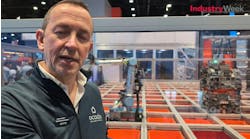Quantum Computing: A New Solution for Supply Chain and Logistics Optimization
World events ranging from the Suez Canal blockage to the global COVID-19 pandemic have shown how susceptible our supply chain management and logistics systems are to changes in consumer and business demand, raw materials availability, shipping, and distribution. The field of constrained optimization is well matched to address these needs, yet today’s classical computers can hit a wall amidst growing volumes of data and unpredictable disruptions. New software solutions will combine the power of classical and quantum computing to help planners stay ahead.
A Challenging Era for Supply Chain & Logistics
Supply chain and logistics managers must constantly balance many, sometimes-conflicting variables to achieve business goals (e.g., flush inventories are good for fulfilling orders and satisfying customers, but the cost can hurt the bottom line). Running lean and mean requires optimizing supply chain and outbound logistics parameters and balancing them against ever-changing customer demand. Everything needs to run like a finely-tuned machine. To minimize the spend on excess stock, you need to accurately forecast demand, ensure just the right supply levels and move supply in and product out in an agile and streamlined way.
Add to these challenges the pandemic-driven shift in e-commerce consumer purchasing from single basket, high volumes (i.e., buying multiple items in one large basket) to many baskets, low volume (i.e., buying a small number of items in multiple baskets), which is compounded by growing consumer expectations of fast and free delivery.
This has only increased while everyone has been stuck at home, creating a last-mile delivery headache for logistics planners. The staggering 154% compound annual growth in same-day delivery points to the importance of optimizing supply chain management logistics. Ensuring next-day or same-day delivery with an ever-increasing volume of packages requires end-to-end optimization of the entire distribution process (fleet management, route planning, etc.), all the way to the customers’ front doors.
These challenges are great application areas to apply quantum computing techniques. Through this approach it becomes possible to analyze complex logistics data for fast, effective delivery and the best possible customer service, retaining customers and growing revenue.
Enter Constrained Optimization
A field of mathematics called “constrained optimization” (CO) addresses these kinds of problems. It is about optimizing a function’s variables (e.g., trucks, SKUs, people), taking into account their constraints (e.g., cost, volume, time), for better business decision-making and efficiency.
For example, consider the famous “traveling salesperson” problem which continues to vex today’s systems. It sounds simple. The challenge is to find the best route for a salesperson to travel, given a list of destinations. Solving this kind of problem requires an analysis of every round trip to find the quickest way. The challenge grows geometrically as the number of stops increases, until it “surpasses the capabilities of even the fastest computers… with 15 destinations, the number of possible routes could exceed 87 billion,” the Routific blog says. This kind of problem is not just hypothetical—it typifies a variety of shipping, logistics and distribution situations.
Constrained optimization can yield high value insights from the complex data that logistics decision-makers use every day. Classical computers are chipping away at tough problems using this method, to generate estimations and approximations. But as our data volumes increase geometrically, they hit a wall.
It’s important to note that more data does not necessarily yield better insights... that is, unless you are able to actually analyze ALL of the data, which is impossible with today’s purely classical computing systems. They simply can’t process burgeoning volumes of data and balance myriad variables. This forces analysts to use all of their mathematical skills to find a way to get the best answers possible, including methods such as compressing info to run a computation or only computing part of the problem, which means the results are not as accurate as they would be if complete data sets were analyzed.
The Quantum Computing Difference
That’s why quantum computers hold so much promise: they can process these kinds of large, extremely complex problems.
Quantum computers process data using multi-faceted qubits (like the binary bits of classical computing, except they hold more than one state at a time). More simply, quantum computers simulate our real-world. They process data and relationships in three dimensions. That means they will be able to crunch much larger volumes of data, even as they simulate all of the inter-relationships between data as they exist, or could exist, depending on different occurrences in contrasting potential realities.
For optimization, quantum computers map your data into a multi-dimensional real-world simulation that depicts the individual data elements and all the relationships. They then simulate probable situations that will result from potential changes in that data. These situations reflect the results you’d experience in the real world.
But quantum computers can deliver more than highly accurate solutions. They can also deliver a diversity of solutions, any of which meet the goals of your optimization. You can get more solutions that are more accurate, using all of the data you’ve paid so much to collect and store. Classical computers, on the other hand, struggle to give accurate, high-quality answers to optimization requests. If they don’t falter completely, they often give only a single probable answer, and it may or may not be accurate.
While the full capabilities of quantum computers are years away, emerging software solutions aim to bridge classical and quantum computing worlds using quantum-ready techniques that produce better results for constrained optimization, using larger data sets on classical computers and eventually for quantum systems. Understanding and implementing quantum computing techniques today can help put supply chain and logistics-reliant companies (e.g., those in e-commerce, manufacturing, transportation, distribution, etc.) ahead of the competition.
Quantum-driven classical, and quantum hybrids offer not only faster results, but more importantly results with a higher accuracy and diversity. This helps businesses get better insight into their increasingly complex decisions and operations.
How Manufacturing Supply Chains Can Benefit
The global pandemic has demonstrated how vulnerable our manufacturing supply chains are to dynamic market conditions. Constrained optimization can help manufacturing supply chains by identifying the best path forward as dynamic conditions change sourcing options and buyer requirements.
Here are some of the benefits of quantum computing and quantum-ready constrained optimization techniques for manufacturing supply chains, from inbound components and raw materials to outbound distribution:
Transportation efficiency: CO can identify optimal locations for manufacturing plants, distribution facilities and other logistics hubs. Small adjustments can make a big difference in the costs and productivity of the overall network.
Warehouse management and distribution services: CO can be applied to optimize global and local shipping and loads, and warehousing and delivery for lowest cost, and highest efficiency and productivity. Having to schedule shipments of thousands upon thousands of computers, televisions, or cars across the globe using existing software tools is not optimal.
Inbound logistics: From order levels to delivery to the production line, CO can drive maximum production levels at the best cost. Even one lost shipment or forgotten vendor can wreak havoc on a production line. Today, having to schedule and maintain all the parts of a car, computer, TV, refrigerator, or ATV using legacy software tools, especially when you’re managing hundreds of thousands of units, is time-consuming and inefficient. CO using quantum-ready methods can make it easier.
Retail and Channel Logistics
CO is an important method to address retail logistics challenges. The pandemic-driven boom in volumes and complexity of e-commerce drive additional use of CO beyond product lifecycle management to focus on effective, low cost and fast delivery. Here are some examples:
Network design factors: The location, number and characteristics of distribution facilities must be optimized for rapid last-mile delivery.
Online order profiles: Facilities and processes must support a much larger volume of orders with a smaller number of items because each order increases the challenge of optimization.
Inventory segmentation: Since many Internet retailers must provide a wide range of diverse products, inventory segmentation within internal and third-party distribution networks must be optimized.
Distribution logistics: Transportation and shipping must be optimized for fast, on-time delivery of high volumes of orders to end-user customers across geographies, down to the last mile.
All the above must be done while controlling costs to support profit margins.
Looking to the Future
Constrained optimization can help streamline everyday supply chain management and logistics decision-making to select the best options from mountains of critical data. Quantum computing techniques can apply CO and empower supply chain and logistics-oriented companies with the in-depth insights needed to optimize their supply chain—from production to warehouse management and final distribution.
You may be thinking, “But quantum computers aren’t ready for prime time yet.” And you’re right, they aren’t. But quantum techniques are available today to enhance your current classical computing while we wait for tomorrow’s hybrid classical/quantum systems and the purely quantum computing systems of the future.
Robert Liscouski is the president and CEO of Quantum Computing Inc., a provider of quantum computing software for real-world business solutions.




